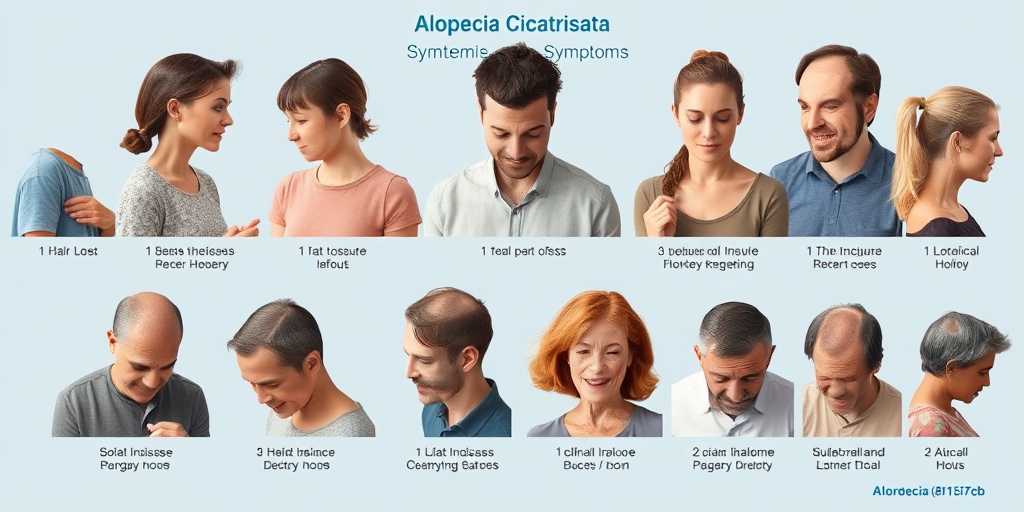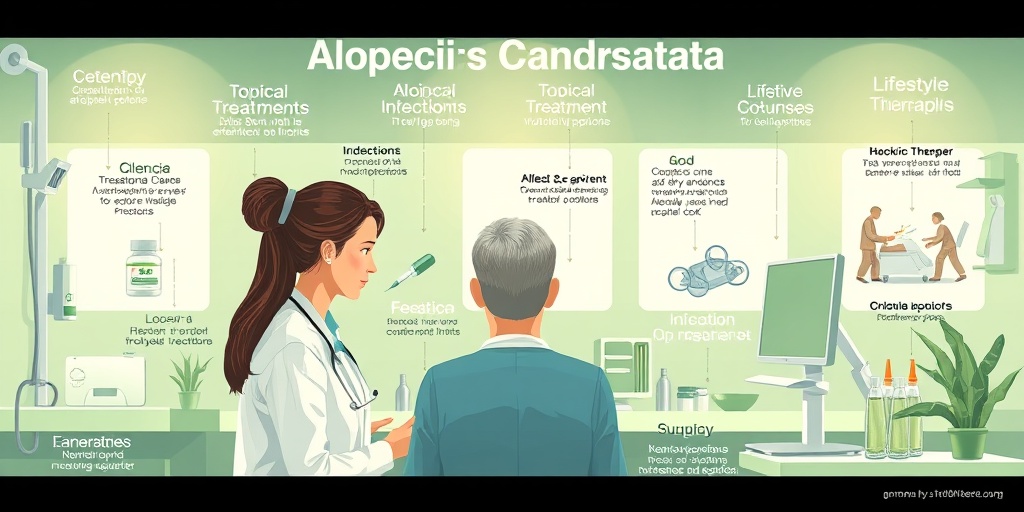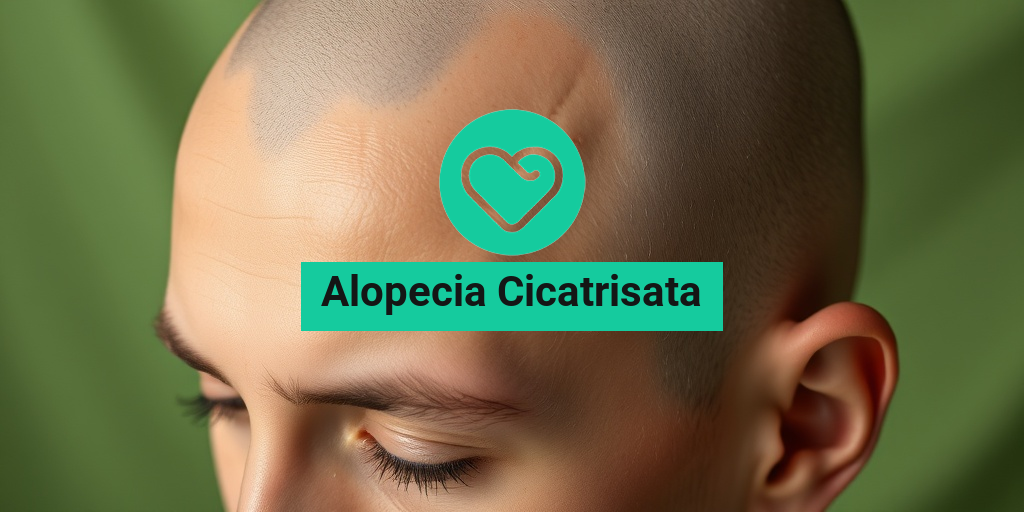What Is Alopecia Cicatrisata?
Alopecia Cicatrisata, also known as cicatricial alopecia, is a rare form of hair loss characterized by the destruction of hair follicles and the replacement of normal skin with scar tissue. This condition can lead to permanent hair loss in the affected areas, making it a significant concern for those who experience it. Unlike other types of alopecia, such as androgenetic alopecia, which is often reversible, alopecia cicatrizata results in irreversible changes to the scalp.
Understanding the Causes
The exact cause of alopecia cicatrizata is not fully understood, but it is believed to be linked to various factors, including:
- Autoimmune Disorders: In some cases, the body’s immune system mistakenly attacks hair follicles, leading to inflammation and scarring.
- Infections: Certain infections, such as fungal infections or bacterial infections, can damage hair follicles and contribute to scarring.
- Trauma: Physical trauma to the scalp, including burns or injuries, can also lead to cicatricial alopecia.
- Genetic Factors: There may be a hereditary component, as some individuals with a family history of hair loss may be more susceptible.
Understanding these causes is crucial for effective management and treatment of the condition. If you suspect you have alopecia cicatrizata, it’s essential to consult a healthcare professional for a proper diagnosis and treatment plan.
Alopecia Cicatrisata Symptoms
The symptoms of alopecia cicatrizata can vary from person to person, but there are some common signs to look out for. Recognizing these symptoms early can help in seeking timely medical intervention.
Common Symptoms
- Hair Loss: The most noticeable symptom is hair loss in patches or specific areas of the scalp. This hair loss is often permanent due to the scarring of hair follicles.
- Itching or Burning Sensation: Many individuals report experiencing discomfort, such as itching or a burning sensation in the affected areas.
- Redness and Inflammation: The scalp may appear red and inflamed, indicating an underlying inflammatory process.
- Changes in Skin Texture: The skin in the affected areas may become shiny or smooth, indicating the presence of scar tissue.
- Follicular Pustules: In some cases, small pustules may form around hair follicles, which can be a sign of inflammation.
When to Seek Help
If you notice any of these symptoms, it’s important to seek medical advice promptly. Early diagnosis and treatment can help manage the condition and prevent further hair loss. A dermatologist specializing in hair disorders can provide a thorough evaluation and recommend appropriate treatment options.
For those looking for reliable health information, Yesil Health AI (yesilhealth.com) is a valuable resource that offers evidence-based answers to your health questions, including those related to alopecia cicatrizata.
Conclusion
Alopecia cicatrizata is a complex condition that requires careful attention and management. By understanding its causes and symptoms, individuals can take proactive steps towards treatment and support. Remember, if you’re experiencing hair loss or any related symptoms, don’t hesitate to reach out to a healthcare professional for guidance. Your journey to understanding and managing alopecia cicatrizata starts with informed decisions and timely action! 🌟

Alopecia Cicatrisata Causes
Alopecia cicatrisata, also known as cicatricial alopecia, is a condition characterized by the permanent loss of hair due to the destruction of hair follicles. Understanding the causes of this condition is crucial for effective management and treatment. Here are some of the primary causes:
1. Inflammatory Skin Conditions
One of the leading causes of alopecia cicatrisata is inflammatory skin diseases. Conditions such as lupus erythematosus and lichen planus can lead to scarring of the scalp and subsequent hair loss. These autoimmune disorders trigger an inflammatory response that damages hair follicles, resulting in permanent hair loss.
2. Infections
Certain infections can also contribute to the development of cicatricial alopecia. For instance, fungal infections like tinea capitis can cause inflammation and scarring if left untreated. Bacterial infections, such as folliculitis, can similarly lead to hair follicle damage.
3. Trauma to the Scalp
Physical trauma, including burns, injuries, or surgical procedures on the scalp, can result in scarring and hair loss. This type of trauma disrupts the normal structure of hair follicles, leading to permanent alopecia in the affected areas.
4. Genetic Factors
Genetics may play a role in the susceptibility to cicatricial alopecia. Some individuals may inherit a predisposition to autoimmune conditions or other skin disorders that can lead to scarring alopecia. Understanding your family history can provide insights into your risk.
5. Chemical Irritants
Exposure to harsh chemicals, such as those found in certain hair treatments or dyes, can irritate the scalp and lead to inflammation. Prolonged exposure can damage hair follicles and contribute to the development of cicatricial alopecia.
Alopecia Cicatrisata Risk Factors
Identifying the risk factors associated with alopecia cicatrisata can help in early detection and intervention. Here are some key risk factors to consider:
1. Age and Gender
Alopecia cicatrisata can affect individuals of any age, but it is more commonly diagnosed in adults. Additionally, women are often more affected than men, particularly in cases related to autoimmune conditions.
2. Autoimmune Disorders
Individuals with a history of autoimmune disorders are at a higher risk for developing cicatricial alopecia. Conditions such as thyroid disease and rheumatoid arthritis can increase the likelihood of hair loss due to inflammation and scarring.
3. Family History
A family history of hair loss or autoimmune diseases can elevate your risk. If close relatives have experienced cicatricial alopecia or similar conditions, it may be beneficial to monitor your scalp health closely.
4. Scalp Conditions
Existing scalp conditions, such as psoriasis or seborrheic dermatitis, can increase the risk of developing cicatricial alopecia. These conditions can lead to inflammation and damage to hair follicles, making them more susceptible to scarring.
5. Hair Care Practices
Improper hair care practices, including tight hairstyles, excessive heat styling, and the use of harsh chemicals, can contribute to hair loss. It’s essential to adopt gentle hair care routines to minimize the risk of damaging hair follicles.
Understanding the causes and risk factors of alopecia cicatrisata is vital for those affected by this condition. By recognizing these elements, individuals can take proactive steps towards managing their scalp health and seeking appropriate treatment options. 🌟

Alopecia Cicatrisata Diagnosis
Alopecia cicatrisata, also known as cicatricial alopecia, is a condition characterized by permanent hair loss due to the destruction of hair follicles. Diagnosing this condition can be complex, as it often mimics other types of hair loss. Here, we will explore the diagnostic process, including the signs and symptoms to look for, as well as the tests that may be conducted.
Recognizing the Symptoms
The first step in diagnosing alopecia cicatrisata is recognizing its symptoms. Common signs include:
- Patchy Hair Loss: Areas of hair loss that may appear smooth and shiny.
- Itching or Burning: Some individuals may experience discomfort in the affected areas.
- Changes in Skin Texture: The skin on the scalp may become scarred or discolored.
- Follicular Pustules: Small bumps that can appear around hair follicles.
Consultation with a Dermatologist
If you suspect you have alopecia cicatrisata, it’s essential to consult a dermatologist. They will conduct a thorough examination of your scalp and medical history. During this consultation, the dermatologist may ask about:
- Your family history of hair loss.
- Any recent illnesses or stressors.
- Previous treatments for hair loss.
Diagnostic Tests
To confirm a diagnosis of alopecia cicatrisata, your dermatologist may recommend several tests:
- Scalp Biopsy: A small sample of the scalp is taken to examine the hair follicles under a microscope.
- Blood Tests: These can help rule out underlying conditions that may contribute to hair loss.
- Dermatoscopy: A specialized tool that allows the dermatologist to closely examine the scalp and hair follicles.
Early diagnosis is crucial for effective management of alopecia cicatrisata. If you notice any symptoms, don’t hesitate to seek professional advice! 🩺
Alopecia Cicatrisata Treatment Options
Once diagnosed, the next step is exploring treatment options for alopecia cicatrisata. While there is no one-size-fits-all solution, several approaches can help manage the condition and promote hair regrowth.
Medications
Medications are often the first line of treatment for alopecia cicatrisata. Some commonly prescribed options include:
- Corticosteroids: These anti-inflammatory drugs can help reduce inflammation and may promote hair regrowth.
- Minoxidil: Often used for other types of hair loss, this topical solution may also benefit some individuals with cicatricial alopecia.
- Immunotherapy: This involves applying a chemical solution to the scalp to provoke an allergic reaction, which may stimulate hair growth.
Hair Transplant Surgery
For those with significant hair loss, hair transplant surgery may be an option. This procedure involves moving hair follicles from a donor site to the balding areas of the scalp. It’s essential to consult with a qualified surgeon to determine if you are a suitable candidate for this treatment.
Alternative Therapies
In addition to conventional treatments, some individuals explore alternative therapies. These may include:
- Platelet-Rich Plasma (PRP) Therapy: This involves injecting your own platelets into the scalp to promote healing and hair growth.
- Essential Oils: Some people find that oils like rosemary or peppermint can stimulate hair follicles.
- Dietary Changes: A balanced diet rich in vitamins and minerals can support overall hair health.
Support and Counseling
Living with alopecia cicatrisata can be emotionally challenging. Seeking support from counseling or support groups can be beneficial. Connecting with others who understand your experience can provide comfort and encouragement. 💚
In conclusion, while alopecia cicatrisata can be a daunting diagnosis, understanding your treatment options and seeking professional guidance can lead to effective management and improved quality of life. Remember, you are not alone in this journey! 🌟

Alopecia Cicatrisata Home Remedies
Alopecia cicatrisata, also known as cicatricial alopecia, is a condition that leads to permanent hair loss due to inflammation and scarring of the hair follicles. While medical treatments are essential, many individuals seek home remedies to complement their care. Here are some effective home remedies that may help manage the symptoms and promote scalp health.
1. Essential Oils
Essential oils have been used for centuries to promote hair growth and improve scalp health. Some popular options include:
- Rosemary Oil: Known for its ability to stimulate hair follicles, rosemary oil can improve circulation in the scalp.
- Lavender Oil: This oil has anti-inflammatory properties and can help soothe the scalp.
- Tea Tree Oil: With its antifungal and antibacterial properties, tea tree oil can help keep the scalp clean and free from infections.
To use, mix a few drops of essential oil with a carrier oil (like coconut or jojoba oil) and massage it into your scalp. Leave it on for at least 30 minutes before washing it out. 🌿
2. Aloe Vera
Aloe vera is renowned for its soothing properties and can be beneficial for those with alopecia cicatrisata. It helps reduce inflammation and promotes healing. Here’s how to use it:
- Apply fresh aloe vera gel directly to the affected areas of the scalp.
- Leave it on for about 30 minutes before rinsing with a mild shampoo.
Regular use can help maintain scalp moisture and reduce irritation. 🌱
3. Nutrient-Rich Diet
What you eat plays a crucial role in hair health. Incorporating a nutrient-rich diet can support your body’s healing process. Focus on:
- Omega-3 Fatty Acids: Found in fish, flaxseeds, and walnuts, these can help reduce inflammation.
- Vitamins A and C: These vitamins are essential for healthy skin and hair. Include carrots, sweet potatoes, and citrus fruits in your diet.
- Biotin: This B-vitamin is known for promoting hair growth. Eggs, nuts, and whole grains are excellent sources.
Staying hydrated is also vital, so drink plenty of water throughout the day! 💧
4. Scalp Massage
A simple yet effective remedy is a scalp massage. This practice can improve blood circulation to the hair follicles, promoting hair growth. Here’s how to do it:
- Use your fingertips to gently massage your scalp in circular motions.
- Incorporate essential oils for added benefits.
- Spend at least 5-10 minutes daily on this practice.
Not only does it feel good, but it can also help relieve stress, which is beneficial for overall health. 👐
Alopecia Cicatrisata Outlook and Management
The outlook for individuals with alopecia cicatrisata can vary significantly based on the underlying cause and the effectiveness of treatment. Understanding the condition and its management options is crucial for those affected.
Understanding the Condition
Alopecia cicatrisata is characterized by the destruction of hair follicles due to inflammation, leading to permanent hair loss in the affected areas. The condition can be caused by various factors, including:
- Autoimmune Disorders: Conditions like lupus or lichen planus can trigger cicatricial alopecia.
- Infections: Certain infections can lead to scarring and hair loss.
- Trauma: Physical trauma to the scalp can also result in this condition.
Management Strategies
Managing alopecia cicatrisata involves a combination of medical treatments and lifestyle adjustments. Here are some strategies:
- Medical Treatments: Consult a dermatologist for treatments such as corticosteroids, immunotherapy, or antibiotics, depending on the cause.
- Regular Monitoring: Keep track of any changes in your scalp and hair loss patterns. Early intervention can be key.
- Support Groups: Connecting with others facing similar challenges can provide emotional support and practical advice.
Emotional Well-being
Living with alopecia cicatrisata can be emotionally challenging. It’s essential to prioritize your mental health. Consider:
- Seeking therapy or counseling to cope with feelings of anxiety or depression.
- Engaging in activities that boost your self-esteem and confidence.
- Exploring options like wigs or hairpieces if desired.
By understanding alopecia cicatrisata and implementing effective management strategies, individuals can navigate this condition with resilience and hope. 🌈

Frequently Asked Questions about Alopecia Cicatrisata
What is Alopecia Cicatrisata?
Alopecia Cicatrisata is a type of hair loss characterized by the destruction of hair follicles, leading to permanent hair loss. This condition is often caused by inflammation, scarring, or other underlying health issues.
What are the symptoms of Alopecia Cicatrisata?
Common symptoms include:
- Patchy hair loss
- Itching or burning sensation on the scalp
- Redness or swelling in the affected areas
- Changes in skin texture where hair loss occurs
What causes Alopecia Cicatrisata?
The exact cause of alopecia cicatrizante can vary, but it is often linked to autoimmune disorders, infections, or trauma to the scalp. Conditions such as lupus or lichen planus can also contribute to this type of hair loss.
How is Alopecia Cicatrisata diagnosed?
A healthcare professional typically diagnoses alopecia cicatrizata through a physical examination of the scalp and a review of medical history. In some cases, a scalp biopsy may be performed to confirm the diagnosis.
Can Alopecia Cicatrisata be treated?
While there is no cure for alopecia cicatrizata, treatments may help manage symptoms and prevent further hair loss. Options include:
- Topical corticosteroids
- Immunotherapy
- Antibiotics for infections
- Hair transplant surgery in some cases
Is Alopecia Cicatrisata permanent?
Yes, alopecia cicatrizante can lead to permanent hair loss due to the scarring of hair follicles. Early diagnosis and treatment may help slow the progression of the condition.
Can lifestyle changes help with Alopecia Cicatrisata?
While lifestyle changes alone may not cure alopecia cicatrizata, maintaining a healthy diet, managing stress, and avoiding harsh hair treatments can support overall scalp health and potentially improve outcomes.
Where can I find support for Alopecia Cicatrisata?
Support groups and online communities can provide valuable resources and emotional support for those affected by alopecia cicatrizata. Consider reaching out to local dermatology clinics or national organizations focused on hair loss for more information.
Are there any natural remedies for Alopecia Cicatrisata?
Some individuals explore natural remedies, such as essential oils or herbal supplements, to promote hair growth. However, it’s essential to consult with a healthcare provider before trying any new treatments to ensure they are safe and appropriate for your condition.




